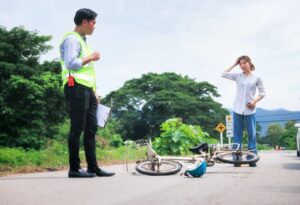How Long Does a Bicycle Accident Claim Take?
How Long Does a Bicycle Accident Claim Take?
A bicycle accident that results from negligent driving can lead to debilitating injuries. This is primarily because bicyclists have direct exposure to their surrounding environment, particularly the ground. Bicyclists may suffer broken bones, traumatic brain injuries, facial contusions, road rash, and other serious medical complications that require prompt medical treatment. If you suffered injuries in a bicycle accident that another driver caused, you must consult with an experienced bicycle accident lawyer as soon as possible.
The time it takes to resolve a bicycle accident claim depends upon many factors, including the specific accident circumstances, the nature and extent of the bicyclist’s injuries, the insurance company or companies involved, and whether litigation is necessary. A skilled bicycle accident lawyer can streamline the case by promptly beginning an investigation into the accident, filing a timely claim or lawsuit, and pursuing recoverable damages via a settlement or litigation.
Why are Bike Accident Injuries So Serious?

Bicycle accidents have the potential to cause serious injuries due to a combination of factors related to the vulnerability of cyclists and the dynamics of these incidents. The primary reason is the lack of protection afforded to cyclists compared to occupants of motor vehicles. Unlike cars with safety features like seat belts, airbags, and structural integrity, bicycles expose cyclists, making them susceptible to direct impact.
The minimal physical barrier between cyclists and the external environment makes them vulnerable to collisions. When a bicycle collides with a vehicle or stationary object, the rider is more likely to absorb the full force of the impact. This can result in severe injuries, ranging from fractures and dislocations to traumatic head injuries.
Head injuries, especially, are a significant concern in bicycle accidents. Cyclists often fall from their bikes upon impact, and if they are not wearing a helmet, the risk of sustaining a traumatic brain injury increases substantially. Helmets can mitigate the severity of head injuries, but their effectiveness relies on proper usage and fit.
The lack of visibility for cyclists also contributes to the frequency and severity of accidents. Drivers may fail to notice cyclists, especially in heavy traffic or low-light conditions, leading to collisions that can result in serious injuries.
The bicycle’s speed and the collision event’s velocity significantly influence the injuries’ severity. Higher speeds increase the impact force, magnifying the potential for more severe injuries. Additionally, the lack of protective barriers means that a collision can lead to significant harm even at moderate speeds.
Road conditions and environmental factors also come into play. Uneven surfaces, potholes, or obstacles on the road can cause cyclists to lose control of their bicycles and suffer injuries.
Overall, the serious injuries associated with bicycle accidents stem from the inherent vulnerability of cyclists, the lack of protective measures, the potential for head injuries, visibility issues, collision speeds, and environmental factors. Addressing these factors through improved safety measures, awareness campaigns, and responsible road behavior can reduce the frequency and severity of bicycle-related injuries.
Evidence in a Bike Accident Claim or Lawsuit
Proving a bicycle accident claim or lawsuit hinges on presenting compelling evidence that establishes liability, damages, and the overall merit of the case. Several types of evidence can be particularly helpful in substantiating a bike accident claim.
- Witness Statements — Eyewitness accounts from individuals who observed the accident can provide crucial perspectives. Their statements can help establish the sequence of events, clarify liability, and offer valuable insights into the incident’s circumstances.
- Photographic and Video Evidence — Clear images or videos taken at the accident scene can be powerful evidence. This includes photos of vehicle damage, road conditions, traffic signals, and relevant signage. Video footage from surveillance cameras or dashcams can provide a detailed account of the accident dynamics.
- Police Reports — Official police reports can serve as a comprehensive accident record. These reports typically include details about the parties involved, statements from witnesses, the officer’s assessment of fault, and any citations issued. A favorable police report can significantly bolster a bike accident claim.
- Medical Records and Professional Testimony — Detailed medical records documenting injuries sustained in the accident are critical. Professional testimony from healthcare professionals can help establish the causal link between the accident and the injuries and provide insights into the extent of medical treatment required and the potential for long-term consequences.
- Accident Reconstruction — In cases where a party contests liability, skilled accident reconstructionists can analyze the evidence to recreate the events leading to the accident. This can help establish a clear picture of how the collision occurred and who may be at fault.
- Maintenance and Inspection Records — If the accident involves a defective bicycle, parts, or negligent maintenance, records related to the bicycle’s condition can be pertinent. This includes inspection logs, repair records, or evidence of any recalls associated with the bicycle or its components.
- Eyewitness Accounts and Statements — Statements from individuals who can attest to the parties’ actions before, during, or after the accident can provide valuable insights. These statements can support or challenge claims made by the cyclist and any other involved parties.
A combination of witness statements, photographic and video evidence, police reports, medical records, professional testimony, accident reconstruction, and relevant maintenance records can collectively strengthen a bike accident claim. Thorough documentation and presentation of these types of evidence are essential for establishing the responsible party’s liability and demonstrating the extent of damages that the cyclist suffered.
Factors That May Affect the Duration of a Bicycle Accident Claim
Various factors can influence the duration of resolving or litigating a bicycle accident case, often contributing to the complexity and length of the legal process. One key element is the extent of injuries sustained by the parties involved. Severe injuries may necessitate prolonged medical treatment and rehabilitation, leading to a more extended legal timeline. Additionally, the severity of injuries often correlates with the amount of compensation sought, adding layers of negotiation and potential disputes.
The availability of evidence also plays a crucial role in expediting or prolonging a bicycle accident case. Clear and compelling evidence, such as eyewitness accounts, surveillance footage, or accident reconstructions, can streamline the legal proceedings. Conversely, a lack of evidence or conflicting information may lead to prolonged investigations and legal battles.
Insurance companies also significantly affect the duration of a bicycle accident case. Delays can arise from disputes over liability, coverage issues, or disagreements on the valuation of damages. Negotiations between attorneys and insurance representatives can extend the resolution process, especially when parties cannot settle outside court.
Furthermore, legal complexities, including the involvement of multiple parties or disputes over liability, can contribute to extended litigation periods. Determining fault and liability may require extensive investigation and legal maneuvering, resulting in a protracted legal battle. Moreover, if the case goes to trial, court schedules, continuances, and the backlog of cases can further elongate the resolution timeframe.
Jurisdictional factors also influence the time it takes to resolve a bicycle accident case. Different regions may have varying legal procedures, court calendars, and statutory timelines, affecting the overall duration of the litigation process.
In addition, the experience and efficiency of legal representation can influence the speed of case resolution. Competent and adept attorneys may navigate the legal landscape more swiftly, whereas inexperienced or overburdened legal teams can contribute to delays.
The duration of resolving or litigating a bicycle accident case is contingent upon factors such as the severity of injuries, availability of evidence, insurance complexities, legal intricacies, jurisdictional considerations, and the proficiency of legal representation. These elements collectively shape the timeline of a bicycle accident case, emphasizing the multifaceted nature of personal injury litigation.
Bicycle Accident Litigation
Bicycle accident litigation involves several legal steps within the court system to seek compensation for injuries and damages. The process typically unfolds as follows:
- Consultation with an Attorney — The injured party consults with a personal injury attorney experienced in bicycle accidents. The attorney evaluates the case’s merits, gathers relevant information, and advises on the potential legal course of action.
- Filing a Complaint — The attorney initiates the legal process by filing a complaint against the at-fault party. This document outlines the details of the bicycle accident, the injuries sustained, and the damages sought. The lawyer for the injured party (the plaintiff) then serves the complaint on the at-fault party (the defendant), notifying them of the legal action. The defendant then has a certain amount of time to respond to the accident victim’s allegations.
- Discovery — Both parties engage in the discovery process, exchanging information and evidence relevant to the case. This process may include interrogatories, document requests, and depositions to gather facts and assess the strength of each party’s side of the case.
- Mediation and Settlement Negotiations — Before trial, parties may engage in mediation or settlement negotiations to resolve without the need to go to court. If the parties reach an agreement, the lawyers document this in a settlement agreement.
- Trial Preparation — If the parties do not settle, they prepare for trial. This involves refining legal arguments, gathering additional evidence, and identifying witnesses to testify.
- Trial — The case goes to trial, where both parties present their evidence, arguments, and witnesses. The judge or jury then determines liability and, if applicable, the damages awarded to the injured cyclist.
Throughout these legal steps, effective communication and collaboration between the attorneys, the court, and the parties involved are essential for a fair and just resolution in bicycle accident litigation.
Compensation Following a Bike Accident

Individuals may be entitled to various economic and non-economic damages in personal injury claims and lawsuits arising from bicycle accidents, each addressing different aspects of the harm suffered. Some of the most common types of recoverable damages include compensation for:
Property Damage — Economic damages may cover the repair or replacement costs for the damaged bicycle and any other personal property affected in the accident, such as clothing or accessories.
Medical Expenses — include costs associated with initial emergency medical care, hospitalization, surgeries, prescription medication, occupational and physical therapy, and ongoing medical care. Economic damages cover current and anticipated medical expenses from the bike accident.
Lost Income — Individuals who sustain injuries in a bike accident cannot work during recovery. Economic damages encompass lost income, including income, bonuses, and other employment benefits that the injured party earned but for the bike accident.
Loss of Earning Capacity — In cases where the injuries have a long-term effect on the individual’s ability to work or earn at their previous capacity, economic damages may encompass the loss of future earning potential.
Emotional Distress — Beyond physical injuries, emotional distress damages may cover psychological trauma (e.g., post-traumatic stress disorder), anxiety, depression, and other emotional challenges resulting from the accident.
Loss of Enjoyment of Life — If the accident causes a significant reduction in the individual’s quality of life, the victim may receive non-economic damages to compensate for the loss of enjoyment of activities and experiences that were once a regular part of their life.
Pain and Suffering — Non-economic damages often include compensation for physical pain, suffering, discomfort, and emotional distress resulting from the bicycle accident. This category is subjective and aims to address the intangible suffering experienced by the injured party.
Loss of Consortium — This refers to damages awarded to a spouse or family member for the loss of companionship, support, or the ability to have a normal marital or familial relationship due to the injuries sustained in the bike accident.
Disfigurement of Scarring — The responsible party may provide compensation for any visible scarring or disfigurement resulting from the bicycle accident.
Remember to note that the availability and calculation of damages can vary based on jurisdiction and the specific circumstances of each case. Seeking legal advice from an experienced personal injury attorney is crucial to understanding one’s rights and pursuing appropriate compensation after a bicycle accident.
Call a Bicycle Accident Lawyer in Your Area Today

Bicycle Accident Attorney, Keith More
Upon suffering injuries in a bicycle accident, you need to involve a skilled personal injury attorney as soon as possible. Your lawyer can swiftly review your legal options and work to maximize the settlement or litigation compensation you recover in your case. Seek your free case evaluation to begin the process of seeking compensation and peace of mind following your injuries.


